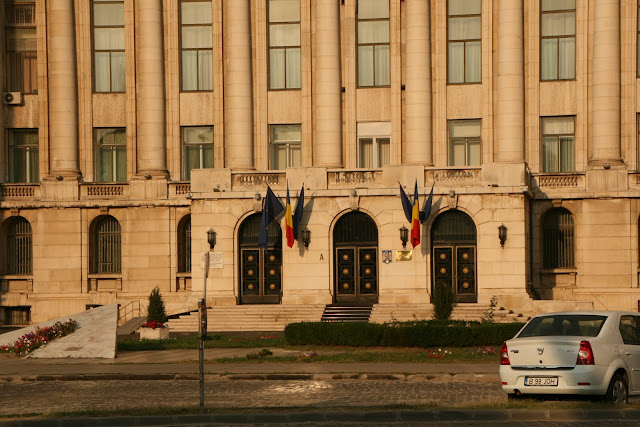Ceausescu and the People's Palace in Bucharest, Romania
 The Palace of Parliament, as the People's Palace is officially called, is the second largest, according to the Guinness Book of Records, as the largest civilian administrative building; the most expensive administrative building; and the heaviest building.
The Palace of Parliament, as the People's Palace is officially called, is the second largest, according to the Guinness Book of Records, as the largest civilian administrative building; the most expensive administrative building; and the heaviest building. It has 1,100 rooms; is 12 stories above ground with at least 4 underground; used 700 architects; cost over $10 billion to build; and has 480 chandeliers. The marble, crystals, carpets and most of the building materials came from Romania and were beautifully crafted by their people. But rather than being the pride of Romania, today it stands mostly empty and still controversial.
The Palace was conceived by Nicolae Ceausescu, who had worked his way up through the Communist party in Romania to become the Secretary General in 1965 and President in 1974. At first, he reached out to form stronger relationships with the West, but after visits to North Korea and Mao's China, he began more repressive measures, formed an erratic personality cult, and titled himself "The Genius of the Capathians."
Under his party leadership, Ceausescu sought to increase the population with policies that outlawed abortion and provided more benefits to families with 5 or more children. Mothers with 10 or more children were called "heroine mothers." Although the population increased, child abandonment also increased as the economy faltered, and many were left in overcrowded orphanages.
After a severe earthquake hit Bucharest in 1977, Ceausescu seized the moment to create his masterpiece: the grandest administrative building in the world that would contain all the branches of the Romanian government--executive, judicial, and parliamentary.
I have heard varying reports as to whether he intended to live in a presidential suite there, but it was not built primarily as his home. He displaced 30,000 people and demolished a beloved monastery on top of the hill, much of the historic district (which had once been called Little Paris--see Bucharest post), needed hospitals, schools, homes, 19 Orthodox churches, and 6 synagogues in order to create his palace, a boulevard wider and longer than the Champs D'Elysee, and numerous museums and government buildings.
I have heard varying reports as to whether he intended to live in a presidential suite there, but it was not built primarily as his home. He displaced 30,000 people and demolished a beloved monastery on top of the hill, much of the historic district (which had once been called Little Paris--see Bucharest post), needed hospitals, schools, homes, 19 Orthodox churches, and 6 synagogues in order to create his palace, a boulevard wider and longer than the Champs D'Elysee, and numerous museums and government buildings.
There were reported 29,000 workers (many of the army) working in shifts for 24 hours a day. As the Romanian economy was struggling, his government borrowed abroad, then tried to pay off the foreign debt by exporting their grain and natural resources. People were starving; the population was growing; children were abandoned; the economy was in shambles; gas was rationed (despite their oil fields); electrical blackouts were ordered; and the country became isolated from the world. Yet, Ceausescu with his wife kept building the palace.
The Palace was almost finished in December 1989 when a protest was crushed in a city in Moldavia, followed by an outbreak in Timisoara, and then a demonstration that turned into riots in Bucharest.
Over several days, about 1,000 citizens were killed. On December 21 in what is now called Revolutionary Square, Ceausescu addressed the crowds from the balcony of the Central Committee Building in what was supposed to be a "support mass meeting." He seemed surprised by the fury of the crowd, as rioters broke open the doors.
Nicolae and Elena Ceausescu fled to the roof where they were rescued by helicopter. Within days, they were captured by police, given a two-hour trial by an ad hoc military court, found guilty, and executed on Christmas Day, 1989. Statues in Revolutionary Square honor those who rose up against tyranny to end the hated regime. A classic building that had been partly destroyed was preserved to remember that moment, but repaired with a modern top.
The Romanian Parliament now occupies part of the building. They hope for tourists to come to pay some of its expenses. One can rent palatial rooms for weddings or banquets--but it's a bit far and too expensive for most.
The Romanian Parliament now occupies part of the building. They hope for tourists to come to pay some of its expenses. One can rent palatial rooms for weddings or banquets--but it's a bit far and too expensive for most.
The paradox: The People's Palace contains exquisite Romanian craftsmanship and materials, yet its very existence is a bitter reminder of a hated era. The expenses of heating, electricity, and security for such a massive structure pull needed money away from their economy. Ceausescu never had the chance to speak to the crowds from the grand balcony. I understand the first to do so was Michael Jackson in his 1992 Dangerous Tour Concert, who said he loved "Budapest" instead of "Bucharest." One more (unintentional) insult to the dreams of a dictator.
[ source ]
More Information:
http://en.wikipedia.org/wiki/Nicolae_Ceaușescu
National Geographic Traveler: Romania
http://en.wikipedia.org/wiki/Nicolae_Ceaușescu
National Geographic Traveler: Romania






.JPG)
